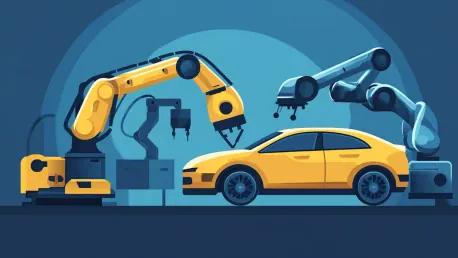Robotics and automation have brought transformative changes to several industries, and the automobile manufacturing sector stands as a prime exemplar of this technological renaissance. The automotive industry is at the forefront of deploying industrial robots, accounting for a significant portion of all installations in the United States. This surge in automation traces back to several pivotal moments in history, beginning with Ransom Eli Olds’ introduction of the first modern auto assembly line in 1901 and culminating in Henry Ford’s revolutionary moving assembly line in 1913. These innovations not only catalyzed mass vehicle production but also laid the groundwork for today’s advanced manufacturing processes.
Historical Milestones Unveiled
The Birth of the Modern Auto Assembly Line
The early 20th century witnessed groundbreaking innovations that set the stage for automation in automobile manufacturing. Ransom Eli Olds was a pioneering force, as his auto assembly line in 1901 marked the beginning of an era where mass production became a reality. The assembly line allowed for the systematic and efficient production of vehicles, significantly reducing the time and effort required for manufacturing. This breakthrough paved the way for larger-scale innovations, including Henry Ford’s transformative moving assembly line in 1913.
Ford’s moving assembly line further revolutionized the industry by mechanizing the assembly process, thereby increasing output and reducing costs. Ford’s vision of making vehicles affordable for the average American was realized through this innovation, which slashed the time to build a car from more than 12 hours to just about 93 minutes. This dramatic increase in efficiency set new standards for the industry and ensured that the automotive sector remained at the forefront of technological advancement. Both Olds and Ford’s contributions are cornerstones that highlight the immense impact of early automation on automobile manufacturing.
Moving Towards Advanced Robotics and AI
The advancements set in motion by Olds and Ford continue to shape the contemporary landscape of automobile manufacturing. Today’s assembly lines are no longer limited to mechanical processes but are infused with sophisticated AI and robotic technologies. These smart factory robots enhance production efficiency by ensuring tasks such as weld quality, engine installation, and high-quality paint jobs are executed with precision and uniformity. The integration of AI in these robots allows for real-time data analysis and adjustments, further optimizing the manufacturing process.
This new era of smart factory robots represents a significant leap from traditional assembly lines. They are not only more efficient but also capable of performing complex tasks that require a high degree of precision. For instance, robotic arms equipped with advanced AI can now handle intricate welding tasks, ensuring consistent quality across all vehicles produced. Engine installations and safety inspections are carried out with meticulous accuracy, reducing the margin for error. In essence, these advancements in robotics and AI have elevated automobile manufacturing to unprecedented levels of efficiency and quality.
Robotics in Vehicle Maintenance
Automation Transforming Maintenance Methods
While the primary focus of robotics in the automotive sector has been on production lines, their influence extends significantly into vehicle maintenance as well. The automation of maintenance tasks such as tire replacement, diagnostic checks, and repairs streamlines processes, reduces human error, and enhances overall service quality. This not only benefits the end consumer but also frees technicians from monotonous and potentially hazardous tasks, allowing them to engage in more complex problem-solving activities. The rise of AI-enhanced maintenance centers is transforming the automotive service landscape.
These AI-driven maintenance centers are designed to expedite the servicing process. For example, automated diagnostic tools can quickly identify issues, reducing the time required for manual inspections. Automated tire replacement machines ensure accuracy and safety, minimizing the risk of improper installations. Additionally, these systems gather vast amounts of data that can be analyzed to predict future maintenance needs, thus preventing potential breakdowns. By incorporating automation into maintenance, the automotive industry ensures that vehicles remain in optimal condition while improving customer satisfaction.
The Future of AI-Enhanced Maintenance
Looking towards the future, AI-enhanced maintenance centers are expected to evolve even further, bringing about a host of benefits for both service providers and vehicle owners. As AI technologies become more advanced, maintenance centers will be able to offer predictive maintenance services, where potential issues are addressed before they lead to breakdowns. This proactive approach not only extends the lifespan of vehicles but also provides peace of mind to owners. Furthermore, reduced wait times and enhanced service quality will become standard expectations, significantly boosting customer satisfaction.
The ability to gather and analyze vast amounts of data through AI also opens avenues for continuous improvement in both production and maintenance. Data-driven insights can lead to the identification of recurring issues, triggering changes in design or manufacturing processes to enhance reliability. The anticipated growth in the automotive robotics market, projected to increase by 12% annually through 2027, underscores the potential for ongoing innovation and cost reduction in car production and shipping. Companies like Nexus Auto Transport are already capitalizing on these trends, offering integrated solutions that include the transport of automotive equipment and industrial robots.
The Evolving Workforce
Job Evolution and Skill Development
One of the most common misconceptions about automation in the automotive industry is that it will lead to widespread job displacement. However, the reality is more complex and optimistic. While certain manual tasks are indeed being automated, this shift is creating new opportunities for workforce evolution and skill development. Automation does not necessarily eliminate jobs; instead, it transforms them, requiring workers to acquire new skill sets that are pertinent to the advanced technologies being deployed. This shift paves the way for the development of a more skilled and adaptable workforce.
For instance, technicians who were once responsible for routine tasks now have the opportunity to engage in higher-level functions, such as overseeing automated systems, troubleshooting complex issues, and programming robots. This evolution necessitates continuous learning and training, ensuring that the workforce remains relevant and capable of handling sophisticated machinery. Educational institutions and automotive companies are collaborating to provide the necessary training programs, thereby fostering a generation of workers who are well-versed in both traditional and modern manufacturing techniques.
Embracing Change for Future Benefits
Robotics and automation have significantly transformed various industries, with automobile manufacturing being a prime example of this technological evolution. The automotive sector leads the way in the use of industrial robots, accounting for a substantial share of all robotic installations in the United States. This increase in automation can be traced back to key historical milestones, starting with Ransom Eli Olds’ creation of the first modern auto assembly line in 1901. The next major leap came in 1913 when Henry Ford introduced the moving assembly line, a groundbreaking innovation that drastically boosted mass vehicle production. These advancements not only enabled large-scale automobile manufacturing but also set the stage for today’s sophisticated manufacturing techniques. As the industry continues to advance, the integration of robotics and automation is expected to keep evolving, further revolutionizing the way vehicles are produced and enhancing efficiency and precision in manufacturing processes.









